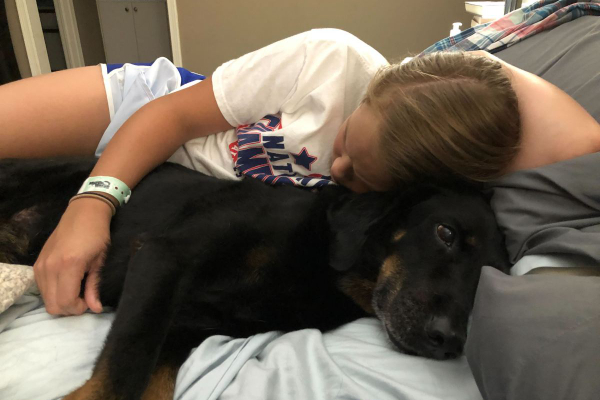Neurological issues in dogs can be scary, especially if your dog suddenly starts having seizures, acting confused, or being unable to walk. Integrative veterinarian Dr. Julie Buzby invites her friend Dr. Leslie Gillette to describe the symptoms that accompany problems with the nervous system, discuss 11 common neurological issues in dogs, and share her dog’s story.

Throughout my veterinary career, I’ve treated countless dogs with neurological diseases. However, because of my beloved rescue hound, Ellie, I became all too familiar with one of the most common neurological disorders in dogs.
Ellie joined our family by way of our local animal shelter. She’d been dropped off one morning for spay surgery along with several other adoption hopefuls. From the first instant I interacted with her, I knew she was special. Ellie was a gentle girl, quickly melting into my lap for ear scratches when I knelt to examine her before surgery.
By that afternoon, I’d decided Ellie simply could not return to the shelter, so I loaded her up in the car and drove her home to meet the rest of her new family.
Ellie immediately bonded with our other dog, Sam, and quickly fell into a routine of playing in the yard, snuggling on the couch with the kids, and sleeping at the foot of our bed. However, late one night, several months after she came to live with us, we were abruptly startled awake by a crashing noise in our room.
As we turned on the lights, we realized the source of the noise was our dear dog. She was lying on the floor against the wall, frantically paddling her feet and twitching uncontrollably. I immediately recognized she was experiencing a neurological problem, namely a seizure.

What is a neurological disorder in dogs?
A neurological disorder is any condition that alters a dog’s normal nervous system function. Depending on the specific condition, neurological disorders may affect areas of the brain and/or spinal cord. Or they may change peripheral nerve signal transmission throughout the rest of the body.
Nervous system anatomy
The canine nervous system includes two main parts—the central and peripheral nervous systems. The central nervous system (CNS) contains the brain and spinal cord. All nervous tissue outside of the brain and spinal cord makes up the peripheral nervous system.
Central nervous system
The brain’s three main components are each responsible for specific functions within the body:
- Cerebrum—Large part of the brain that controls the higher functions, including memory, learning, logical thought, and emotions.
- Cerebellum—Walnut-shaped portion at the back of the brain that controls fine motor functions, including balance and coordinated movement.
- Brainstem—Junction of the brain and spinal cord which controls vital functions including consciousness, breathing, heart rate, and reflexive actions like coughing, sneezing, and swallowing.
The job of the spinal cord is to transmit signals between the brain and the body. This vital bundle of nervous tissue extends down the spine from the brainstem to coordinate the movement of the head and limbs, respond to sensations like thirst, hunger, pain, and temperature fluctuations, and control urination and defecation.
Peripheral nervous system
The peripheral nervous system (PNS) encompasses all nervous system connections outside the brain and spinal cord. This vast network of nerves includes the cranial and spinal nerves and the neuromuscular junctions. Together, these structures help facilitate communication between the brain and the body.
- Cranial nerves—Twelve paired sets of sensory and/or motor nerves that are responsible for all the functions of the face and head. They help facilitate seeing and blinking, hearing, smelling, chewing and swallowing, and balancing.
- Spinal nerves—Paired nerves that extend from the spinal cord to all four limbs, the bladder, anus, and tail. The spinal nerves help coordinate actions like urination, defecation, walking, and, most importantly, tail-wagging!
- Neuromuscular junctions—Terminals (called synapses) where a motor neuron communicates with a muscle fiber to initiate a muscle contraction.
There are two divisions of the peripheral nervous system—autonomic and somatic. The autonomic nervous system regulates functions outside of your dog’s conscious control, such as breathing, heart rate, and digestion.
The somatic nervous system controls conscious actions like chewing food, jumping, running, and chasing frisbees in the yard. It does so by transmitting messages between your dog’s spinal cord and musculoskeletal system.
What causes neurological problems in dogs?
Anything that disrupts the function of these nervous system components can lead to the development of neurological issues. Depending on the underlying cause, symptoms can be subtle and slow to develop (like we see with degenerative myelopathy or doggy dementia). Or more severe problems may develop suddenly and progress rapidly (like IVDD or vestibular disease).
Some conditions can affect dogs of any age, while others are more prevalent in mature and senior dogs. Older dogs are most susceptible to neurological problems caused by degenerative diseases, vascular disorders, and tumors.

Degenerative diseases
Degenerative diseases occur when components of the dog’s neurological system begin to wear out or break down. For example, intervertebral disc disease (IVDD), which is also called degenerative disc disease, occurs when the discs between the vertebrae weaken and bulge into the spinal canal.
Vascular disorders
Vascular disorders in dogs develop when normal blood flow to the brain or other areas of the body is interrupted. This disruption of blood flow can occur for various reasons:
- A blood clot or a piece of intervertebral disc blocks a vessel (e.g. fibrocartilaginous embolism or FCE)
- The dog bleeds into the brain itself or the area around the brain (intracranial hemorrhage), which increases pressure inside the skull
- Inflammation of the vessels interrupts normal circulation through the brain tissue
Tumors
Several types of tumors, both cancerous and benign, can affect a dog’s brain, spinal cord, and peripheral nerves. Some common tumor types include meningiomas, glioblastomas, and nerve sheath tumors.
What are neurological symptoms in dogs?
Dogs with neurological issues may show various signs (physical or behavioral changes or a combination of both). The symptoms you see will depend on the underlying cause, severity, and how quickly the disease progresses.
The most common symptoms of neurological disorders in dogs include:
Lack of coordination and loss of balance
Sometimes the dog may have subtle difficulty with balance and a lack of coordination which may be isolated to specific tasks. For example, dogs with cerebellar disease may experience intention tremors. This means they start shaking when attempting to perform fine motor movements like eating, drinking, or trying to pick up a toy.
On the other hand, some conditions cause more widespread and severe loss of balance. You may notice your dog looks wobbly and off balance. The technical term for this unsteady or uncoordinated gait is ataxia. In more severe cases, the dog may not even be able to stand upright or walk.
Circling
A dog with neurological issues may start walking in circles. These circles might be small or large and always one direction or varied in the direction. Physical issues, like a stroke or brain tumor can cause circling. But cognitive decline, which tends to have more behavioral than physical symptoms, can also cause periodic circling.

Seizures
Seizures in dogs occur in various forms, including:
- Focal seizures (fly-biting, facial twitching, dog staring into space)
- Generalized, severe episodes (tonic-clonic, grand mal seizures) where the dog becomes unconscious, paddles, and may lose bowel or bladder control
- Prolonged seizure activity (single seizure lasting longer than 5 minutes or multiple seizures right on top of each other), known as status epilepticus.
Nystagmus (abnormal eye movement)
Dogs with neurological issues may have unusual movement of the eyes (nystagmus). This symptom is often due to a problem with the vestibular system, which helps with balance and spatial orientation. Depending on the underlying cause, these eye movements can be horizontal (side to side), vertical (up and down), or rotational.
Head tilt
Dogs may develop a head tilt with repeated, chronic inner ear infections or as a lingering effect of vestibulitis (inflammation within the vestibular system). Tumors may also cause a head tilt due to abnormal pressure on the brain or cranial nerves.
Knuckling
You may notice knuckling in dogs, which is the inability to place a foot in its proper position (right side up) when standing or walking. Knuckling usually indicates nerve damage, spinal cord injury, or a progressive degenerative or neuromuscular disorder.
Limb weakness or paralysis
Knuckling on one or more feet can progress to paresis (weakness in one or more limbs) or paralysis. A weak dog may look wobbly, scuff or drag the paws when walking, or have trouble standing and moving his or her legs. On the other hand, a paralyzed dog will be completely unable to stand on or move the affected legs.
Limb weakness and/or paralysis typically accompany spinal cord disorders. These symptoms may involve only the hindlimbs (paraplegia) or all four limbs (quadriplegia), depending on the underlying cause and the level at which the nervous system is affected.
Back pain, neck pain, or pain in other areas
You may notice signs your dog is in pain such as increased panting, tense or abnormal body position (hunched back, holding the neck outstretched and low, etc.), changes in attitude, or crying out. Pain in dogs with neurological disease may be due to the presence of a space-occupying tumor. Or neck or back pain can be secondary to spinal-related disease (e.g. IVDD, Wobbler disease, or discospondylitis).
Tremors
There are a few different types of tremors that may accompany neurological conditions. Head tremors in dogs are often related to an underlying cerebellar disease. And they tend to affect fine motor movements like eating and drinking. However, there are also idiopathic head tremors in dogs, which are harmless.
Generalized body tremors can be an indication of toxin exposure, certain infections, metabolic problems, or pain. If the dog has nerve pain, he or she may experience body tremors in the form of exaggerated skin twitching (hyperesthesia) when you touch a painful area.
Disorientation or personality changes
Your dog may seem confused, disoriented, or become aggressive toward other animals or people. Or you may notice that he or she forgets the location of common objects (e.g. the food and water bowl or the door to go outside) or shows other mental status changes.
Excessive or abnormal vocalization
Sometimes a painful dog may whimper or cry out, but keep in mind that many dogs suffer in silence. Additionally, dogs with cognitive impairment may whine, howl, or bark as part of a disruption of their regular sleep-wake cycles or due to anxiety.

Blindness
Some dogs may become blind if a tumor, stroke, or other neurological condition interferes with the portions of the nervous system that control vision. Blind dogs tend to bump into objects, be reluctant to walk, or seem disoriented.
Lethargy
Lethargic dogs will be less physically active and lack their normal energy and stamina. Instead, they may prefer to just lie around or only play for a short time before getting tired. Additionally, dogs with behavioral changes may also be less interactive. For example, they may refuse to seek out affection or play with humans or other pets in the home.
Loss of appetite
Sometimes the dog may not seem as eager to eat as usual. This is a general symptom that is not always part of neurological disorders in dogs. But it can occur secondary to nausea if the dog is experiencing vestibular symptoms.
What are the most common neurological disorders in dogs?
Now that you understand how to recognize the symptoms of neurological conditions, let’s take a look at 11 common problems.
1. IVDD (intervertebral disc disease)
IVDD in dogs occurs when the intervertebral discs, which lie between the vertebrae and just below the spinal cord, push upward and compress the spinal cord. The result is an abrupt onset of back or neck pain, limb weakness, or paralysis. IVDD is prevalent in older, small-breed dogs (think Dachshunds, Basset Hounds, and other “low-rider” breeds). However, degenerative disc disease can develop in dogs of any age or size.
2. Degenerative myelopathy (DM)
Degenerative myelopathy in dogs (DM) occurs due to deterioration of the white matter in the spinal cord (the portion responsible for nerve signal transmission). This causes progressive hindlimb weakness and urinary or fecal incontinence. Sadly, in the end stages of DM, the dog may be paralyzed. Dogs with degenerative myelopathy experience a more gradual physical decline versus IVDD, where symptoms usually develop suddenly.
Degenerative myelopathy is diagnosed primarily in large and giant breed dogs (German Shepherds, Boxers, Bernese Mountain Dogs, Rhodesian Ridgebacks, Chesapeake Bay Retrievers). However, DM can also affect smaller breeds (Pugs, Corgis, Shelties, Wheaton Terriers). Older dogs are more likely to develop DM, but large and giant breeds may have a younger age of onset than smaller breeds.
3. Seizures
Seizures in dogs can develop in dogs of any age, and certain breeds may be predisposed. The most commonly diagnosed type of seizure disorder is idiopathic epilepsy. However, infections, metabolic diseases, toxins, and brain tumors may also cause seizures.
Depending on the underlying cause, seizures may be focal— like a stargazing or flybiting episode in which a dog may appear to be staring off into space or snapping at something that isn’t there.
Or seizures can be generalized. This is the “classic” seizure where the dog experiences full body tremors, leg paddling, altered consciousness, loss of normal response to verbal cues (meaning your dog doesn’t respond to your voice), and spontaneous urination or defecation during the episode.
Keep in mind, if your dog has a continuous seizure lasting more than 30 minutes (status epilepticus), this can be life-threatening. Please make an emergency vet visit immediately.
4. Wobbler syndrome

Wobbler syndrome (cervical spondylomyelopathy) is another neurological issue primarily affecting large and giant breed dogs (Great Danes, Dobermans, German Shepherds, Rottweilers, Irish Wolfhounds, Mastiffs). It can develop due to spinal cord compression or disc herniation. Or it may be secondary to bony changes along the spinal vertebrae that pinch or compress the soft nerve tissues.
Wobbler syndrome causes significant neck pain and a wide-based stance with an unsteady, “wobbly” gait when walking. This characteristic gait is where the name Wobbler syndrome came from.
5. Vestibular disease
Vestibular disease in dogs is a balance disorder that can affect dogs of any age. It occurs when something disrupts the vestibular system, which is made up of the inner ear, brain, and associated nerves. The vestibular system gives the body information about its position in space. Tumors or ear infections (otitis in dogs) can cause vestibular disease, but it can also be idiopathic, meaning the cause is unknown.
Symptoms typically develop rapidly and can be pretty dramatic. Affected dogs have difficulty walking and may fall repeatedly, circle in one direction, develop nystagmus (abnormal eye movements), or experience a loss of appetite and nausea. Some dogs may also develop a head tilt, which may not resolve entirely even after other symptoms have subsided.
6. Canine cognitive dysfunction
Canine cognitive dysfunction (CCD), or doggy dementia, affects dogs as young as six years of age, but is most often identified in older dogs. CCD results from poor blood flow to the brain tissue and a buildup of plaque-like lesions (called amyloid) that disrupt normal neuron function. It is similar to Alzheimer’s disease in older humans.
The onset of signs of dementia in dogs is usually gradual. But hallmark symptoms include a change in sleep-wake cycles, disorientation, abnormal pacing and vocalization at night (sundowning in dogs), loss of previous house training, and changes in social interactions with familiar people and pets.
7. Cerebellar hypoplasia
Cerebellar hypoplasia is a developmental disorder of young puppies that occurs because the cerebellum does not develop appropriately. Causes include poor nutrition, oxygen deprivation, infection, exposure to toxins, and trauma.
Dogs with cerebellar hypoplasia may experience intention tremors (shaking and incoordination when trying to do a fine motor activity). This makes eating, drinking, and other coordinated fine motor movements more difficult. Intention tremors can worsen with excitement, so they are often more prominent at mealtime.
8. Brain tumors
Brain tumors in dogs can affect any breed of dog at any age, although certain breeds are overrepresented. Boston Terriers, Boxers, and Pugs are brachycephalic (short-nosed) breeds at a higher risk for certain types of brain tumors. Gliomas, which usually affect the cerebrum, and pituitary tumors, which can cause Cushing’s disease in dogs are more common in those breeds.
German Shepherds, Collies, Golden Retrievers, and other dolichocephalic (long-nosed) dogs, by contrast, are more susceptible to developing meningiomas. This type of tumor affects the protective layer of the brain (meninges) rather than the brain itself.
Depending on the tumor type and size, you may see a variety of symptoms including seizures, loss of vision or hearing, changes in personality, neck or back pain, difficulty walking, or loss of normal reflexes. Cancers that develop around the head and neck may also cause visible facial drooping, a change in pupil size, and elevation of the third eyelid on the affected side (Horner’s syndrome in dogs).
9. Congenital disorders
Congenital neurological issues are those that arise from a problem during fetal development. Hydrocephalus in dogs, or “water on the brain”, is a common congenital disorder identified in small and toy-breed dogs, particularly Chihuahuas.

10. Stroke
While less common than in people, true strokes in dogs (those caused by disrupted blood flow to the brain) do occur. Stroke symptoms may happen due to bleeding in or around the brain, which increases the intracranial pressure. Or they may be the result of a blood clot that blocks the flow of blood in the brain.
More often though, dogs actually suffer from a spinal stroke in dogs (also called a fibrocartilaginous embolism or FCE). This condition occurs when a piece of disc material breaks off and ends up in the blood vessels that supply the spinal cord. When the disc material blocks blood flow to the spinal cord, that portion of the cord starts to die. As a result, the dog experiences non-painful weakness or paralysis, which may be worse on one side than the other.
11. Meningitis or encephalitis
Dogs can develop inflammation of the protective layer that covers the brain (meningitis), brain (encephalitis) or spinal cord (myelitis). Infectious diseases (bacterial, viral, protozoal, fungal, or tick-borne diseases in dogs) are common causes of inflammation. They can affect dogs of any age or breed.
Some dogs may also develop immune-mediated inflammation of the brain, meninges, and spinal cord, known as granulomatous meningoencephalomyelitis (GME in dogs). This condition is more commonly diagnosed in toy or small-breed female dogs.
How will the vet test for neurological disorders in dogs?
If you are seeing symptoms that could go with one of these neurological issues (or another condition not on the list), please make a veterinary appointment. During the appointment, the vet will ask you questions about your dog and perform a complete physical and neurological exam.
After that, the vet may recommend starting with blood work and X-rays to get baseline information about your dog’s health. In some cases, your vet may then refer you to a veterinary specialist near you, namely a neurologist, for additional testing.
Blood work
Running blood tests for dogs will help your vet identify potential causes of the neurological issues such as metabolic diseases, infections, and certain types of cancer (e.g. lymphoma in dogs).
X-rays
Conditions such as spinal stenosis, spondylosis in dogs, collapsed intervertebral spaces, discospondylitis in dogs, and bony tumors can cause changes in the bone that the vet may be able to identify on an X-ray. Plus, in dogs with cancer, X-rays can help identify signs of metastasis (spread) from a primary tumor site.
Spinal fluid examination (CSF tap)
The vet may perform a spinal tap. This involves collecting a sample of cerebrospinal fluid (CSF) from your dog under anesthesia. Testing the CSF can provide valuable information about your dog’s neurological issues. It may be able to indicate whether the underlying cause is infection, inflammation, neoplasia (cancer), a nutritional deficiency, or a metabolic abnormality.
CT scan
Computerized tomography (CT) is a highly specialized form of imaging that can assist with cancer staging. Your vet can also visualize bone and blood vessel abnormalities using CT scans, sometimes with the help of contrast fluid injected through a catheter during the procedure.
MRI
Magnetic resonance imaging (MRI) is another type of specialized testing that can identify injuries or abnormalities affecting soft tissue structures. Examples include abnormal brain conformation or spinal cord compression from IVDD.

What is the treatment for dogs with neurological issues?
Based on your dog’s diagnosis, your vet can recommend a variety of treatment and management modalities to keep your dog as comfortable and symptom-free as possible. Some of the more common treatment options include:
Prescription medications
Your vet may recommend several medications to manage your dog’s neurological disorder.
- Steroids (e.g. prednisone for dogs) and NSAIDs (e.g. carprofen for dogs) to relieve musculoskeletal pain and inflammation
- Anti-seizure medication (e.g. phenobarbital, potassium bromide, or zonisamide for dogs) to help decrease the severity, frequency, or length of seizures
- Anti-nausea medications (e.g. Cerenia for dogs, meclizine for dogs, or metoclopramide) to help relieve nausea and vomiting due to vestibular disease or other conditions.
Dietary changes
Maintaining a healthy nutritional regimen is vital for dogs at every stage of life. For example, suppose your dog is experiencing signs of cognitive decline. Your vet may recommend transitioning to a diet rich in omega fatty acids, medium-chain triglycerides, and other antioxidant ingredients to support your dog’s brain health.
Nutritional supplements
If changing diets is not an option for your dog, your vet may recommend adding a nutritional or health support supplement to his or her daily routine. Supplements containing omega-3 fatty acids for dogs (DHA and EPA), medium chain triglycerides (such as Dr. Buzby’s Brain Boost™ organic MCT oil for dogs), and antioxidants like SAMe may help support your dog’s overall physical and cognitive health.
Mobility support
Navigating hard surface floors and stairs can be challenging for dogs with compromised mobility due to hindlimb weakness, arthritis pain, or even vision issues. If your dog is struggling with poor mobility, ask your vet about mobility aids you can use at home.
Dr. Buzby’s ToeGrips® dog nail grips are rubber rings that go on your dog’s toenails to provide grip wherever he or she goes. If your neurological dog scuffs his or her feet, you should glue the ToeGrips on to prevent them from getting pulled off by the dragging motion.
Alternatively, you can try using yoga mats or other non-skid flooring options for dogs with traction issues. Plus, ramps or non-skid steps can help your dog safely navigate furniture (especially if your four-legged friend still sleeps with you at night) and vehicles to reduce the risk of an accidental fall.
If your dog has trouble getting up or needs support going up and down stairs, a wearable full body mobility harness such as Help ‘Em Up Mobility Harness can be very helpful. Or you could consider using the GingerLead® Support and Rehabilitation Harness if your dog just needs intermittent hind end support.
Alternative therapies
Many alternative and integrative therapies offer great promise in supporting dogs with neurological issues. Depending on your dog’s diagnosis, your vet may suggest consulting with a veterinarian certified in rehabilitation or integrative care to discuss the benefits of:
- Hydrotherapy (underwater treadmill for dogs)
- Acupuncture for dogs
- Laser therapy for dogs
- Stem cell therapy
- Dog chiropractic care
- PEMF for dogs (targeted pulsed electromagnetic field therapy)
- Physical therapy
Cancer treatments
If your dog has been diagnosed with cancer, treatment options may look a little different than the other modalities mentioned above. Depending on the specific diagnosis and staging, the vet or veterinary oncologist may recommend chemotherapy, radiation, or palliative care for your dog.
When considering the various cancer treatment and management options, it’s important to be mindful your dog’s overall quality of life. It can be helpful to ask yourself, “Does treatment have the potential to give me more good time with my beloved dog? What sort of a toll might treatment take on my dog and my family?”
What is the prognosis for dogs with neurological issues?
Depending on your dog’s specific neurological issue, his or her long-term prognosis may vary. Supportive care can allow many dogs to enjoy a good quality of life for months to years after diagnosis. However, other dogs with more severe conditions may not achieve the same longevity.

Working closely with your vet will ensure the best treatment, management, and palliative care options available to support your dog’s quality of life during the remainder of his or her golden years.
The rest of my dog’s story
The morning after Ellie’s episode, I took her to work with me in hopes that diagnostic testing would be able to identify the reason for her seizure. However, her test results were completely normal, which helped rule out a metabolic cause of the seizures.
Since there was nothing I could identify to treat, I took her home after work and crossed my fingers that this would only be a one-time episode. That did not end up being the case though.
Ellie continued to have seizures sporadically throughout her life with us. But they never interfered with her overall quality of life. Our sweet girl eventually crossed the rainbow bridge at 12 years old due to kidney failure, which was unrelated to her seizure history.
Don’t lose hope
While my dog’s story didn’t end the way I would have liked, my goal in sharing it is to convey a message of hope. Neurological problems in dogs can be scary to navigate but are by no means a life-limiting condition in every case. It is possible that your dog could have many good months or years ahead of him or her. Even if that isn’t the case, you can still make every effort to treasure the time you do have left together.
If your dog is showing any neurological symptoms, the best thing you can do is get him or her to the vet promptly. By carefully observing your dog, taking a proactive approach to any potential problems, and working closely with your veterinarian, you can help your senior dog navigate whatever neurological issues may arise.
Has your dog experienced a neurological issue?
Please comment below.


My chihuahua mix (rescued, unknown age but estimated to be around 14) suddenly became disoriented, began circling, had trouble standing and developed a head tilt and personality change overnight in 2019. Our vet could not find the cause but she rapidly improved on steroids. We weaned her off after about nine months and she stabilized but her little personality was forever changed. She has ataxia and lost her bark and her desire to play. She mostly lays in her little beds and it has sometimes been tough to encourage her to eat but she otherwise enjoys a good quality of life and can navigate most things just fine. Sometimes, though, she will improve suddenly. Want to eat double what she usually does, her ataxia seems to be improving to a normal gait and she seeks out more affection. I often wonder if we are experiencing something more like a disease but should I be concerned when she does seem to improve, is that a sign of something worsening? I just never know how to judge if she’s okay or needs a check up. Thank you for this article!
Hi Heather,
I am sorry your girl has been through so much over the past few years. I would love to offer insight or advice, but without knowing the cause of these issues, it is hard to make specific conclusions. Is her blood work normal? To get the answers you are seeking it may require a visit with a neurologist. Hoping there is a way to finally get a definitive diagnosis. Wishing your sweet girl all the best.
My 15 1/2 year old Doxie has Cushing Disease and takes Vetoryl. He made improvements on the medication. Recently, as he is aging, we see increased issues. He has started to circle and has more trouble walking. To fight he circled and fell to the side and I noticed side to side eye movements. I’m going to try to see my vet tomorrow but would welcome your feedback. I don’t want him to suffer but this is so hard to think about even though I know he is almost 16 years old.
Thank you for your comment, in advance.
Dear Evelyn,
My heart goes out to you as you continue to care for your senior Dachshund. I am glad you were planning to contact your vet and hope they were able to give you some answers. From what you describe, I am extremely suspicious about a brain lesion or seizure activity. How are things today? Praying all is well and feel free to leave an update if you have a chance.
Was reading about seizures in dogs and my Australian Silky Terrier (12 years old) two years ago got diabetes and is blind and has little hearing . He gets two insulin shots a day (10ml) at 6;00am and 6:00pm . He’s developed seizures and I know when they start as he gets weak and wobbly and jerks his head. He does eat while having these seizures and I give him a taste of orange juice and hold him for about 10-15 minutes and he gets out of the seizures. At this point his kidneys are functioning , bowels, eating etc plus he’s not losing weight. i don’t know what to do at this point.
Hi David,
I am sorry your senior pup is having these worrisome seizure episodes. How long has it been since your boy had a glucose curve performed? The reason I ask is you would want to rule out the possibility that the insulin is dropping his glucose too low and actually causing these seizures. It would be an easy fix to adjust his insulin dosage if that turned out to be the culprit. Also, if needed, there are simple medications that can be administered to help control seizures. Your vet would be able to choose the appropriate one for your pup and monitor his progress. I am hopeful you can partner with your vet to restore your dog’s quality of life and give him many happy days ahead. Best wishes and keep up the good work!